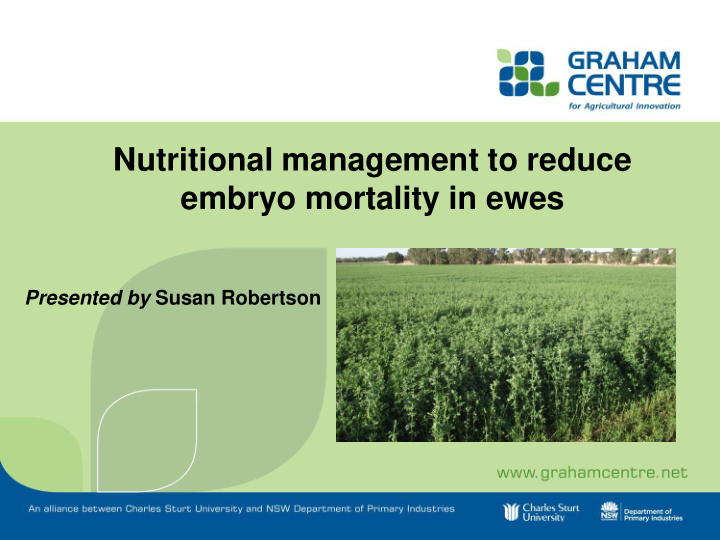



Nutritional management to reduce embryo mortality in ewes Presented by Susan Robertson
Background • Flushing increases ovulation rate = more twin lambs • Lamb survival important • Short-term flushing more efficient • Lupin grain or live pasture
Background -Flushing trial 2012 • Aim: to determine whether short-term flushing increases fetal numbers in unsynchronised ewes • Ewes grazed lucerne or dead pasture for 7 days before and 7 days of joining (about 65% flushed) Feb/Mar
Background -Flushing trial 2012 • Up to 21 extra fetuses/100 ewes scanned • Ewes must be cycling when flushed • Other live pastures as effective as lucerne Number of fetuses/ewe scanned 1.8 b 1.7 y No. Fetus/ewe 1.6 a lucerne 1.5 x dead pasture 1.4 1.3 1.2 Holbrook Walbundrie The Rock Marrar
Background -Flushing trial 2012 • Would grazing lucerne through joining = more lambs? • Does lucerne increase embryo mortality?
Background In synchronised, pen-fed ewes (barley/lucerne pellet) : • 2 x energy requirement = embryo mortality • Sensitive to low progesterone Day 11-12 Energy level % ewes pregnant % pregnant (xM) (with CIDR - progesterone) 200% 48 a 76 100% 68 b 65 25% 67 b 60 Source: Parr et al. 1987, 1992
Background • Excess nitrogen/protein may cause embryo mortality • More likely if sub-maintenance energy • Is high protein in lucerne a concern?
MLA funded Pen trial 2013-2014 Does the timing or quantity of lucerne fed influence embryo mortality and fetuses scanned? Where insemination = Day 0: 1. 0-17 days Control pellets M 2. 0-17 days Lucerne M 3. 0-17 days Lucerne ad lib 4. 0-7 days Lucerne ad lib 5. -7-17 Lucerne ad lib
Pen trial results Mean reproductive performance of ewes in five treatments (2013 and 2014). Proportion Proportion No. pregnant pregnant Fetus/ewe scanned ewes with multiples Control 0.67 0.34 b 0.90 0-17 M 0.63 0.32 b 0.83 0-17 ad lib 0.69 0.18 a 0.81 Minus 7-17 ad lib 0.59 0.23ab 0.73 0-7 ad lib 0.57 0.22 ab 0.71 Feeding high levels of lucerne to synchronised AI ewes reduces twinning rate
MLA funded Grazing trial 2014 Does grazing lucerne change lambs born in naturally cycling ewes? 1. Dead pasture 2. Lucerne 7 days before to 7 days of joining 3. Lucerne 7 days before and throughout joining
Grazing trial 2014 Lucerne Day 7 of joining Lucerne Day 36 of joining Dead Day 7 of joining
Grazing trial results Dead pasture Lucerne Lucerne throughout to Day 7 Raddled to Day 14 (%) 88 92 83 Non-pregnant (%) 12 6 6 No. fetuses/ewe 1.31 a 1.61 b 1.60 b
Conclusions • In naturally cycling autumn-joined ewes, grazing lucerne for 7 days before and during joining can increase the number of twins born • Where most ewes mate early during joining, grazing past day 7 of joining may not increase fetal numbers • Avoid feeding high energy to oestrus synchronised and AI ewes to minimise embryo mortality
The funding of Meat & Livestock Australia is gratefully acknowledged Contact details: Susan Robertson, School of Animal and Veterinary Sciences, Charles Sturt University, Wagga Wagga Ph: 02 6933 4199, Email: surobertson@csu.edu.au
Recommend
More recommend